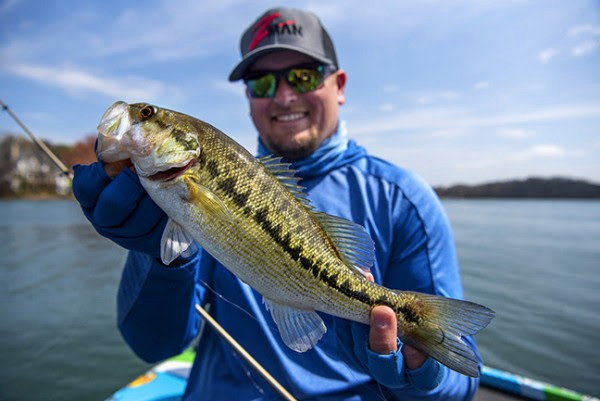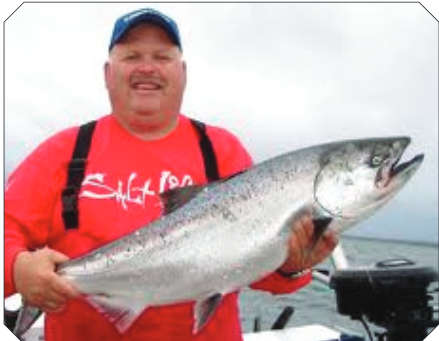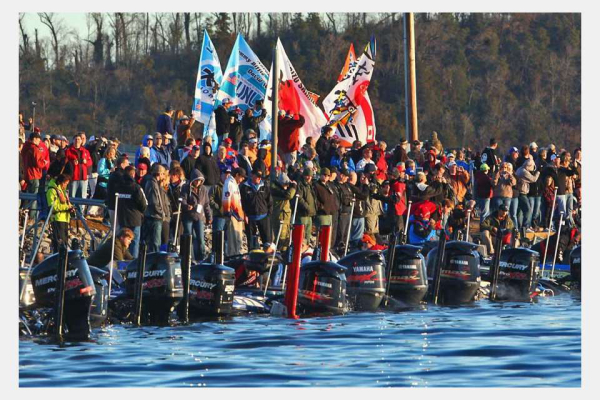September Jackson Bass
with Keith Dawkins
September can be the most
frustrating time of year for bass fishermen.
The water is as hot as it gets and the oxygen content is at its lowest
level of the year. The days are still hot and uncomfortable and the bass are
sluggish. But some lakes, like Jackson, offer you a chance to catch fish and
forget the problems.
Jackson is an old Georgia Power
lake at the headwaters of the Ocmulgee River.
It is lined by docks and rocks are plentiful. There are good points that
run out to deep water and humps that hold bass.
Shad are the primary forage this time of year and you can find the shad
and catch bass.
In the 1970s and 1980s Jackson was
known for big largemouth. Then spots
were illegally stocked in the lake by misguided fishermen and they have taken
over the lake. Rather than catching a seven pound largemouth now you are going
to catch seven one pound spots.
Spots are fun to catch and taste
good, so enjoy catching them and eat them.
You can’t hurt the population of bass in the lake by keeping every one
you catch. In fact, fisheries biologists say keeping all of them, even those
under 12 inches long, may help a little. They have no size limit anywhere in
Georgia except Lake Lanier.
Keith Dawkins grew up fishing
Jackson. His parents still have a house
there and he spends several days a month on the lake. For years he fished the Berrys tournaments
and bigger trails like the Bulldog BFL but his job now keeps him from fishing
tournaments.
“Early in September bass are out on main lake
structure, feeding on shad,” Keith said.
As the month progresses they push up the points and toward the coves. By
the end of the month, depending on the shad, they may be way back in them.
A wide variety of baits will catch
fish. Keith always has a Flash Mob Jr.
with small swimbaits on the arms and a Fish Head Spin on the middle one. He also likes a buzz bait, popper and X-Rap
five inch bait with props on both ends for top water fishing and a Fluke or
Senko rigged weightless for fishing over structure and cover.
For faster fishing a 300 Bandit
with white and chartreuse is good as is a #7 Shadrap in black and silver. When he slows down and probes the bottom he
will have a Carolina rigged Trick worm and a Spotsticker jig head with a Trick
worm on it.
If you are seeing fish on your
depthfinder but can’t get them to hit, get right on top of them and use a drop
shot worm. Drop it down to them and jiggle it slowly. If they are right on the bottom let your lead
stay on the bottom but raise it up to the depth the fish are holding if they
are suspended.
Keith showed me the following ten
places in mid-August. Small spots were
on them during the day. The afternoon before we went he caught some quality
spots and largemouth right at dark, an indication the bigger fish were probably
feeding at night. Those bigger fish will be feeding on these places during the
day in September.
1. N
33 20.606 – W 83 51.667 – The big point where the river turns downstream across
from the mouth of Tussahaw Creek is a good place to start early in the morning
or to fish late in the day. It is a big
flat where wood washes in and hangs up and there are a couple of small pockets
on it and small points run off it.
Start on the upstream end where the
biggest cove on the point starts. There
are rocks on it and it drops fairly fast.
As you fish downstream the bottom flattens out and there is a lot of
wood to fish. Stay way out on the flat
in seven to eight feet of water since it is so shallow and cover all the wood
with a buzz bait.
Fish all the way around the point
where it turns to the left going downstream.
Also try a crankbait around this wood in case the fish don’t want a
topwater bait. A weightless Fluke or Senko is also good around the wood.
2.
N 33 20.313 – W 83 51.404 – Go down the river and there is a marked hump
way off the left bank. There are two danger markers on it and it tops out about
six feet deep at full pool, dropping off to 40 feet deep. Keith warns that boat
wakes move the markers and they may not be right on top of it, so idle up
toward them slowly. The hump has rocks,
stumps and brush piles on it the bass use for cover, and they will also hold in
the saddle between the hump and the bank.
Start with your boat in deeper
water and fish all the way around it, casting topwater and crankbaits to the
top of the hump and working them back. Also try the Flash Mob Jr. here, fishing
it the same way. Watch your depthfinder
as you go around it for fish holding deeper.
Try a Carolina rig and a jig head
worm on this hump, too. Keith likes to
drag both baits along slowly, letting the lead stir up the bottom to attract
attention. Keith usually uses a Trick
worm on both, preferring watermelon seed or pumpkin seed colors, but if the
bass want a smaller bait he will go to a Finesse worm. He will often dip the
tails of both size worms in chartreuse JJs Magic for added attraction.
We caught some small spots here on
a drop shot when Keith saw fish near the bottom. If you see them off the sides of the hump try
that. Also, especially during the day, you can sit on top of the hump and cast
a Carolina rig or jig head worm to the deeper water, working your bait up the
drop.
3.
N 33 19.317 – W 83 50.574 – On the right side of the dam going toward it
the Georgia Power park and ramp are on a big point right beside the dam. There are two DNR docks in the pocket formed
by the dam and point and there are “Boats Keep Out” buoys in front of them. There is a public fishing pier on this side
of the point.
A lot of wood washes in and sticks
in this pocket, and the DNR and residents sometimes pull floating wood to it,
so there is a lot of cover to fish. The bottom is also rocky and drops off into
deep water. In the morning or late
afternoon start in the pocket, fishing the wood. Try topwater and a weightless
bait like a Fluke or Senko around it, too.
When the sun is high sit way out
even with the big park point but toward the dam side, and line up with the two
tallest towers on the power station on the bank. A ridge runs out parallel to the park point
and flattens out on the end, and bass hold on it. Fish it with your bottom baits and run a
crankbait and the A-Rig over it
4. N 33 19.584 – W 83 50.563 – Go
back upstream to the big point on the left where the river turns back to the
left. Downstream of this point, straight
out from a cream colored boat house with a metal dock in front of it, a hump
rises up to about 14 feet deep. Line up the end of the point with the park side
of the dam and idle along this line. You will be in about the middle of the
mouth of the creek coming out on the park side.
Keith caught his biggest spot from
Jackson on this hump. Sit out in deep
water and drag your bottom bumping baits on it. Try a drop shot, too. Also run
a crankbait across it for suspended fish.
Keith does not always bump the bottom with a crankbait but fishes it
like a fleeing shad in the water column. He may go to a deeper running bait
like the DD22 if the fish won’t come up for a more shallow running bait.
5.
N 33 20.028 – W 83 50.753 – Going upstream on the right bank, on the
upstream point of the third big cove upstream of Goat Island, you will see a
house and dock with bright silver roofs on the point. There is a seawall around the point and big
rocks are on it. As the bank goes upstream there are huge boulders where it
turns into a bluff bank.
Stay way off the bank, the rocks
come out a long way, and cast a crankbait or A-Rig to them. Then try your jig head worm and Carolina rig
around them. Fish all the way around the
point. Way off the point a hump comes up
and the saddle leading out to it can be good.
Watch for schooling fish here and
other similar places. There were several
schools of small keeper spots chasing shad all around this point when we fished
and Keith got one on his XRap. They will
school even better in September and you can chase schooling fish most of the
day.
6. N 33 20.145 – W 83 50.852 – Going up stream
along the bluff bank a narrow point comes out at the upper end of it. There is riprap around the point and a narrow
pocket upstream of it. The point runs
way out and Keith says bass hold out on the point early in the month and feed
on shad. Later in the month they will push shad up into the bay on the
downstream side and into the narrow pocket upstream of it.
Fish the
point with your Carolina rig, A-Rig and jig head worm. Stay way out with your boat in at least 15
feet of water to fish the point early in the month. Later fish the cover in the
bay and pocket on both sides with Senko or Fluke but try you’re A-Rig in the
pockets, too. Keith likes the light
Flash Mob, Jr and does not put heavy jig heads on it so he can fish it shallower
without hanging up.
7. N 33 20.840 – W 83 51.985 – Go
to the mouth of Tussahaw Creek to the right side going in. A ridge comes up way
off this bank and tops out about 14 feet deep. You will see a light brown roof
dock in front of a white cabin on the right bank and the ridge starts about
even with it and runs into the creek.
Fish up the ridge into the creek
until you are even with a dark brown dock.
Try you’re a-Rig and crankbait over the top of it, keeping your boat on
the river side in deeper water. Then
fish it with bottom bumping baits probing for the rocks and stumps on it. Watch here, too, for fish on the bottom and
try a drop shot for them.
8. N 33 21 094 – W 83 52.213 – Go
on up Tussahaw to upstream side of the first small cove. There is a tall tree
stump carved into a bear standing behind a dock on the bank. Start at the dock
in front of the bear and fish upstream.
Fish hold on this point and the next one upstream, too, and feed early
in the month then push shad into the coves on both sides of the points later.
Fish will often hold on docks so
Keith works them carefully. He will fish every dock post with a jig head worm,
hitting the post and letting the bait drop straight down it. He says spots often nose up to the post and
if the bait does not fall straight down beside it they won’to hit. Keith says he will often spend a half hour
carefully fishing every post on a dock. A Senko or Fluke will also catch dock
bass.
Fish the points and banks going
into the pockets with A-Rig and crankbait.
When fishing the crankbait Keith says he likes to crank it a few feet
then pause it. Strikes will often come just as he starts the bait moving again.
Try different lengths of pause before moving it again.
9. N 33 22.180 – W 83 51.728 – Go
up the Alcovy to the mouth of the South River. As you go into the mouth of it,
on your right, the second point is narrow and has an old boat ramp on it. This point comes way out and has a lot of
rocks on it and holds a lot of bass. Keith caught several spots here on his
crankbait.
Run your crankbait and A-Rig across
the point. If there is any current coming
out of the river, which often happens after a rain, Keith says it is important
to stay on the downstream side of the point and cast upstream, working your
baits with the current.
Also fish a Trick worm or Senko on
top of the point early. It is very shallow a good way off the bank. Then work your bottom baits on the point, all
the way out to the end of it in at least 15 feet deep. You will get hung up in the rocks but that is
where the bass live.
10.
N 33 23.028 – W 83 50.590 – Run up the Alcovy River under the
powerlines. Upstream of them a ridge
runs parallel to the river channel way off the left bank upstream of the first
creek on that side. Watch on the right
bank for a white deck on the bank just off the water with lattice work under
it. It is very white.
If you stop in the middle of the
lake even with that deck and idle toward the far bank, at a very slight angle
upstream, you will cross the ridge. The ridge is on the far side of the river
channel and it tops out about 14 feet deep and has stumps and rocks in some
spots on it.
Keith likes to keep his boat on the
side of the ridge away from the river channel and fish it. He says bass tend to
hold on that side and stripers hold on the river side. Cast you’re a-Rig and crankbait over the top
of it and work your Carolina rig and jig head down that side from the top to
about 20 feet deep. Also watch for fish under the boat to use your drop shot.
Since the rocks and stumps are in
patches, feel for them and concentrate on that area. The end of the ridge is where Keith catches
most of his fish.
Give Keith’s places a try and see
the kind of structure and cover he likes this month. There are many similar
places you can find and fish on Jackson.




